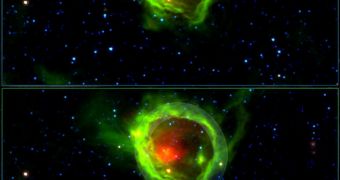A group of scientists announces that they will soon launch the Milky Way project, an endeavor aimed at enlisting the help of the general public in cataloging some of the most peculiar structures in the Milky Way.
The initiative comes from the same experts that brought you the Galaxy Zoo and Moon Zoo projects, among many others. The overall effort, to make more sense of the Universe we live in, is called Zooniverse, and includes all the smaller endeavors.
In the new project, people who access the website will be asked to catalog odd structures inside our galaxy, such as for example gas bubbles, gas knots, dust accumulations and star clusters.
All of the images that will be displayed to participants were collected during automated surveys of the night sky, carried out in the infrared portion of the electromagnetic spectrum.
The Galactic Legacy Infrared Mid-Plane Survey Extraordinaire (GLIMPSE) and the Multiband Imaging Photometer for Spitzer Galactic Plane Survey (MIPSGAL) are the main investigations that provided not-yet-cataloged data for the project.
At the very core of the Milky Way Project (MWP) is the large-scale participation of the general public. The very reason such endeavors are set up is because it is too time-consuming for researchers to carry out this process on their own.
Additionally, computer models can easily make mistakes when it comes to recognizing shapes, and assigning them automatically to predefined categories. Humans can distinguish shapes more easily and extrapolate the nature of a space object based on previously-seen images of similar bodies.
Accompanying the MWP are the Milky Way Talk forums, where users can submit interesting photos of space structures for discussions and classification, Universe Today reports.
The MWP site can be accessed at all times. It contains MIPSGAL images taken in the 24- and 70-micron wavelengths, and GLIMPSE photos collected in wavelengths of 3.6, 4.5, 5.8, and 8 microns.
Some of the most interesting structures in our galaxy cannot be readily seen in optical wavelengths, but they appear very clear in infrared. Given that the Milky Way has a diameter of 100,000 light-years, there are plenty of objects to discover.
In addition to helping astronomers better understand the Milky Way, you could also discover new space structures, that will then be the target of observations carried out with the world's most advanced telescopes.

 14 DAY TRIAL //
14 DAY TRIAL //